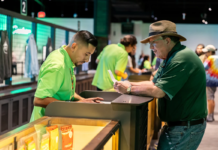Long before cannabis legalization began to take hold in the United States, a primordial soup of marijuana stereotypes and medical advocates were the primary driving forces in creating a passionate subculture and lucrative marketplace. These two core audiences appeared relatively easy to define and support with products and branding.
Although primitive, this mixture of Cheech and Chong, Dennis Peron, and Snoop Dogg gave cannabis its identity and some straightforward avenues for marketing among brands.
In 2022, America is steadily marching toward legalization one state at a time, creating a highly fragmented and diverse set of marketplaces that have become far more difficult to define. The use and efficacy of medical marijuana continue to gain momentum both politically and scientifically. At the same time, the stigma around adults enjoying the plant as a recreational product is slowly making way for a growing acceptance among every major demographic across the country.
Even the most cynical cannabis advocate must admit that these developments are remarkable.
But what has widespread acceptance done to cannabis culture? If the plant is now a mass-produced product with something valuable to offer for nearly everyone, how does that change the marketing opportunities?
One great example of this shift is Claybourne Co., a premium cannabis company out of California that’s normalizing cannabis through a different lens. They have recently added professional bull rider and “working man’s cowboy” Eli Neocochea to their list of brand ambassadors, as well as Baja 1000 champion Chris Gil who runs an AC/heating company to finance his love of racing dirt bikes. “You won’t see any flashy, hype beast, Rolls Royce driving, Gucci wearing Claybourne Co. ambassadors. There’s nothing wrong with that, it’s just not us,” said Claybourne Co. CEO & Co-Founder Nick Ortega in a press release.
Harrison Wise is the Founder and President of Wise Collective, a 15-year-old, full-service integrated marketing and communications agency involved in the cannabis industry. He sat down with mg Magazine to discuss the changing landscape.
“I’m happy to say [cannabis acceptance] has evolved, probably more so in the last decade than in the last several decades,” he said. “There’s still a long way to go, but it’s certainly become a more acceptable, mainstream substance.”
Among other accomplishments, Wise Collective was the agency responsible for launching the MedMen brand in 2015 with the impetus of presenting cannabis as a mainstream product across the country.
“That was our platform for the brand as a whole. From a retail perspective, the perception was to make them the Apple Store of weed. Apple Store is globally recognized as a brand and widely accepted as being at the forefront of innovation and design,” said Wise.
He added that although mainstream acceptance is expanding, the perception is different geographically. “The coasts are more liberal by nature, and therefore the stigmas have fallen a lot quicker,” he said. “Middle America, the South, [the stigma] still exists.”
Wise feels that the way it stands today, he would recommend branding and marketing products very differently depending on which parts of the United States a company is targeting. “The tastes and preferences of markets like Oklahoma are going to differ from Massachusetts, [who will] differ from the target demographics in Florida, which is a medicinal state only,” he noted. “All of those factors should be taken into consideration.”
Wise added that geography is not the only item to take into account when figuring out how to reach a specific audience. “It’s important to really do the market research and take the time to understand your brand voice, your values, and your mission,” he said. “What is it you want the marketplace to know about your brand? You need to create consistent messaging around that.”
Educating consumers remains a priority
Cannabis, as compared to other products, is still in its infancy when referring to this legal renaissance after more than 70 years of prohibition. Because of this reality, Wise also believes that brands still need to focus on educating their target demographics as much as possible.
“For a lot of brands it’s still important to be rooted in education,” he said. “Really elevate the knowledge of your target customer base.”
Wise pointed out that it’s important to parlay the education in a way that speaks to the customer as opposed to just spouting off information. “By providing information in a way that can be understood by anyone reading it, brands can make a lasting impact on consumers and provide their staff with valuable educational material,” he said. “Simply writing content around a set of products isn’t going to make an impact, brands must focus on the questions the consumer has. Creating trust between your brand and your target audience is started when brands make an effort to address their consumers’ questions and concerns.”
Another important point that certainly should not be dismissed is the fact that cannabis culture as a whole is still constantly evolving, so the messages of today might not resonate with the customer mindset a year from now. This is especially true in new markets where residents haven’t had the same opportunities to experience cannabis through the wide variety of product categories available in more developed markets like Colorado.
“Martha Stewart was certainly a factor in contributing to mainstream cannabis, making it accessible to a whole new demographic of people. In California they were targeting soccer moms early on after legalization,” said Wise. “But like I said before, there’s still such a long way to go. Like Weedmaps demonstrated for the Super Bowl, cannabis ads are still marginalized and not accepted in mainstream media, whereas alcohol and gambling ads are accepted.”
One of the best ways to target your products and market them accordingly is to understand the landscape to the best of your ability. Customers and their shopping habits are being monitored closely by numerous data firms including Headset, BDS Analytics, New Frontier, and many others — knowing as much as possible about your customers and regional market preferences can mean the difference between failure and success.










[…] cannabis culture, people expect an energizing, uplifting high from a “sativa” strain of cannabis. On the other […]
[…] and modular waiting areas,” he continued. “We wanted to create this cheeky, disruptive, countercultural influence. The customer journey is super-important, so we installed express checkout stations for quick […]
[…] blossomed in the Big Apple in recent years. Brands like Sackville, Gossamer, and House of Puff have opened the aperture on cannabis culture to include those less than inspired by garish green leaves and lingering reggae […]
[…] a variety of review platforms including Leafly, Google, Weedmaps, and Yelp. From plant advocacy and cultural connection to free parking and veteran discounts, there are quite a few reasons each one of these dispensaries […]
[…] make [a business in this industry] work. You have to think bigger than the plant, and you have to tap into other cultures and have other relationships with those cultures that actually have meaning and […]
[…] easily recognizable cannabis fan leaf has served as the weed culture mascot for decades, but ensuring fan leaves are properly managed throughout the vegetative and […]
[…] the music, skate, surf, snowboarding, heady communities,” Kaye said. “But we appeal to tons of different subsets of culture, from people who love to smoke and explore new products to someone who’s had no experience with […]
[…] which include music, art, fashion, food, and, of course, tons of cannabis. Dedicated to D.C.’s cultural development, Cannabliss consistently involves local vendors in its community outreach initiatives. The store […]
[…] reference standard amounts. This can be quite confusing to someone without a scale or experience in cannabis culture when trying to determine how much a gram, eighth, quarter or ounce of cannabis costs and what a […]
[…] Many cultures would advance the practical aspect of packaging in the ensuing centuries, but it wasn’t until the eighteenth century a particular creative flair was brought to packaging design. Spurred by revolutionary developments in printing technology and industrial production, suddenly product packaging featured color, illustrations, logos, and slogans that evolved into the kernels of brand recognition. […]
[…] of showcasing a proven track record in a crowded field, the specifics of a brand’s ties to culture and heritage also offer a direct bridge to connecting with customers and belief systems. Be it the seasoned […]